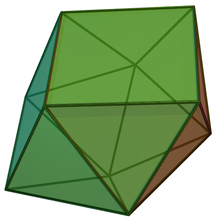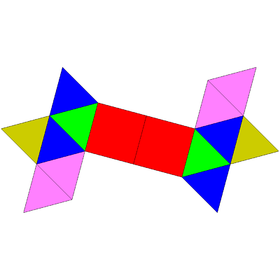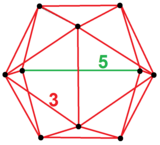
In geometry, the gyroelongated square cupola is one of the Johnson solids (J23). As the name suggests, it can be constructed by gyroelongating a square cupola (J4) by attaching an octagonal antiprism to its base. It can also be seen as a gyroelongated square bicupola (J45) with one square bicupola removed.

In geometry, the gyroelongated pentagonal rotunda is one of the Johnson solids (J25). As the name suggests, it can be constructed by gyroelongating a pentagonal rotunda (J6) by attaching a decagonal antiprism to its base. It can also be seen as a gyroelongated pentagonal birotunda (J48) with one pentagonal rotunda removed.

In geometry, the square gyrobicupola is one of the Johnson solids. Like the square orthobicupola, it can be obtained by joining two square cupolae along their bases. The difference is that in this solid, the two halves are rotated 45 degrees with respect to one another.

In geometry, the gyroelongated pentagonal birotunda is one of the Johnson solids. As the name suggests, it can be constructed by gyroelongating a pentagonal birotunda by inserting a decagonal antiprism between its two halves.

In geometry, the pentagonal cupola is one of the Johnson solids. It can be obtained as a slice of the rhombicosidodecahedron. The pentagonal cupola consists of 5 equilateral triangles, 5 squares, 1 pentagon, and 1 decagon.
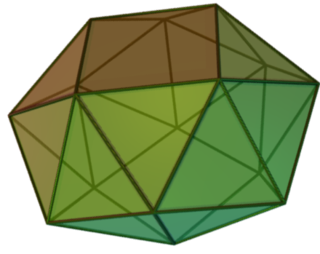
In geometry, the snub square antiprism is the Johnson solid that can be constructed by snubbing the square antiprism. It is one of the elementary Johnson solids that do not arise from "cut and paste" manipulations of the Platonic and Archimedean solids, although it is a relative of the icosahedron that has fourfold symmetry instead of threefold.

In geometry, the sphenomegacorona is one of the Johnson solids. It is one of the elementary Johnson solids that do not arise from "cut and paste" manipulations of the Platonic and Archimedean solids.

In geometry, the triangular hebesphenorotunda is one of the Johnson solids.

In geometry, the elongated triangular bipyramid or triakis triangular prism is one of the Johnson solids, convex polyhedra whose faces are regular polygons. As the name suggests, it can be constructed by elongating a triangular bipyramid by inserting a triangular prism between its congruent halves.

In geometry, the elongated pentagonal cupola is one of the Johnson solids. As the name suggests, it can be constructed by elongating a pentagonal cupola by attaching a decagonal prism to its base. The solid can also be seen as an elongated pentagonal orthobicupola with its "lid" removed.
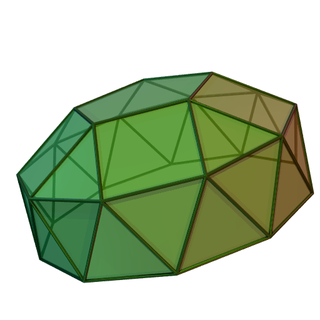
In geometry, the gyroelongated pentagonal cupola is one of the Johnson solids (J24). As the name suggests, it can be constructed by gyroelongating a pentagonal cupola (J5) by attaching a decagonal antiprism to its base. It can also be seen as a gyroelongated pentagonal bicupola (J46) with one pentagonal cupola removed.

In geometry, the pentagonal orthobicupola is one of the Johnson solids. As the name suggests, it can be constructed by joining two pentagonal cupolae along their decagonal bases, matching like faces. A 36-degree rotation of one cupola before the joining yields a pentagonal gyrobicupola.

In geometry, the pentagonal gyrobicupola is one of the Johnson solids. Like the pentagonal orthobicupola, it can be obtained by joining two pentagonal cupolae along their bases. The difference is that in this solid, the two halves are rotated 36 degrees with respect to one another.

In geometry, the elongated pentagonal gyrobicupola is one of the Johnson solids. As the name suggests, it can be constructed by elongating a pentagonal gyrobicupola by inserting a decagonal prism between its congruent halves. Rotating one of the pentagonal cupolae through 36 degrees before inserting the prism yields an elongated pentagonal orthobicupola.
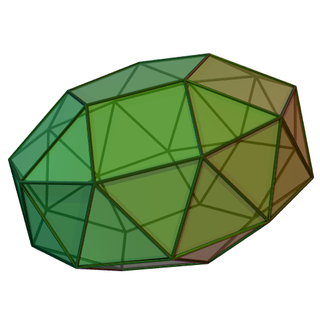
In geometry, the gyroelongated pentagonal bicupola is one of the Johnson solids. As the name suggests, it can be constructed by gyroelongating a pentagonal bicupola by inserting a decagonal antiprism between its congruent halves.

In geometry, the elongated triangular cupola is one of the Johnson solids. As the name suggests, it can be constructed by elongating a triangular cupola by attaching a hexagonal prism to its base.
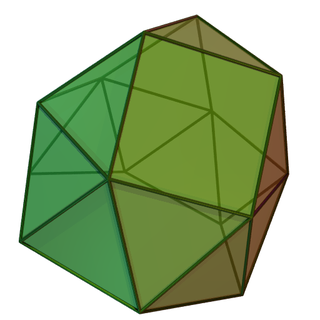
In geometry, the gyroelongated triangular cupola is one of the Johnson solids (J22). It can be constructed by attaching a hexagonal antiprism to the base of a triangular cupola (J3). This is called "gyroelongation", which means that an antiprism is joined to the base of a solid, or between the bases of more than one solid.

In geometry, the pentagonal orthocupolarotunda is one of the Johnson solids. As the name suggests, it can be constructed by joining a pentagonal cupola and a pentagonal rotunda along their decagonal bases, matching the pentagonal faces. A 36-degree rotation of one of the halves before the joining yields a pentagonal gyrocupolarotunda.
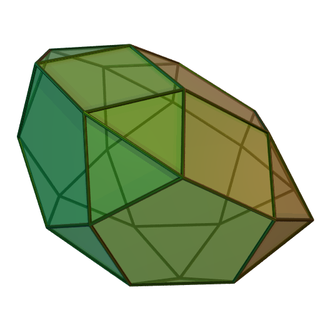
In geometry, the pentagonal gyrocupolarotunda is one of the Johnson solids. Like the pentagonal orthocupolarotunda, it can be constructed by joining a pentagonal cupola and a pentagonal rotunda along their decagonal bases. The difference is that in this solid, the two halves are rotated 36 degrees with respect to one another.

In geometry, the elongated pentagonal gyrocupolarotunda is one of the Johnson solids. As the name suggests, it can be constructed by elongating a pentagonal gyrocupolarotunda by inserting a decagonal prism between its halves. Rotating either the pentagonal cupola or the pentagonal rotunda through 36 degrees before inserting the prism yields an elongated pentagonal orthocupolarotunda.
